![]() 1st Battalion 22nd Infantry
1st Battalion 22nd Infantry ![]()
Regulars Open the NTC at Fort Irwin
by Don Krewson
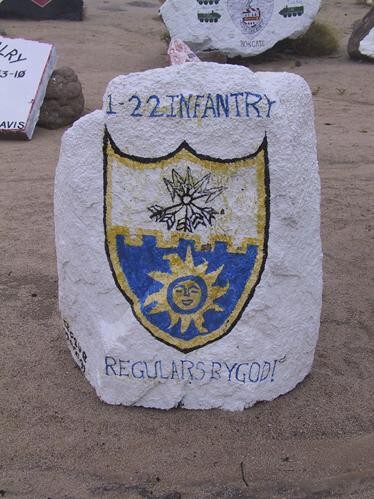
A rock painted by 1st
Battalion 22nd Infantry during one of their
training missions at the NTC.
Photo by Andrei Pashkin
(Ed., From 1972 to late
in 1980 Fort Irwin was a California National Guard base, used as
a training area
by that organization and by US Army Reserve components. The
National Training Center (NTC)
was officially declared activated on October 16, 1980 at Irwin.
On July 1, 1981 Fort Irwin was redesignated
as an active installation of the US Army.
In the years leading up
to the decision to activate the NTC, different units of the Army
travelled to Fort Irwin
and conducted training exercises there, to test the viability of
the NTC concept, and explore the changing
tactics of the new mechanized Army.
Today the Battalion and
the Brigade loads its vehicles on railcars to send to the NTC for
training.
In 1978 1/22 Infantry travelled to Fort Irwin for the first time
as part of a 300 vehicle convoy
from Fort Carson that stretched along the highway for miles. It
must have been quite a sight.)
Opening Ft. Irwin
This would have been in March or April of 1978. One morning, CSM
Pesta told me to get HQ6 ready for a road march in 3 days.
He didn’t tell me where we were going, just that I needed to
have canvas on the jeep with doors. This was fairly common for
him.
We made a kind of game out of keeping me on my toes. The canvas
in itself was great entertainment because I had never put
canvas on a jeep and didn’t even have any for HQ6. I
scrounged some up from somewhere, probably 704th Maint.
I had good contacts there. I remember it cost me a new set of
combo wrenches to get it though. The next morning we had an
alert.
Everyone went through a processing center in the field house
where we had vaccinations, married troops had wills made out,
everything we needed for an overseas deployment. Reforger
wasn’t due until 79, so I figured we were moving to Ft. Hood
as part of their Project Masters and Market Garden operation.
Project Masters was an open pocketbook and wasted
a LOT of money with dumb stunts like this. That afternoon, we had
the wreaker sit small conex containers on the supply docks,
loaded all our weapons in them, and set two each, doors to doors,
in the back of 5 5-tons. I had never seen anything like this
before,
so I started doing some checking. I found out from a guy I knew
at G-2 that we were moving to ft. Irwin, CA for a few weeks.
I was raised Army and had never heard of the place. He just told
me it was an old closed post in the Mojave near Barstow.
Now I had something to work with. In those days, most maps
didn’t show military installations by name.
When I found it on a Rand-McNally map I was even more confused.
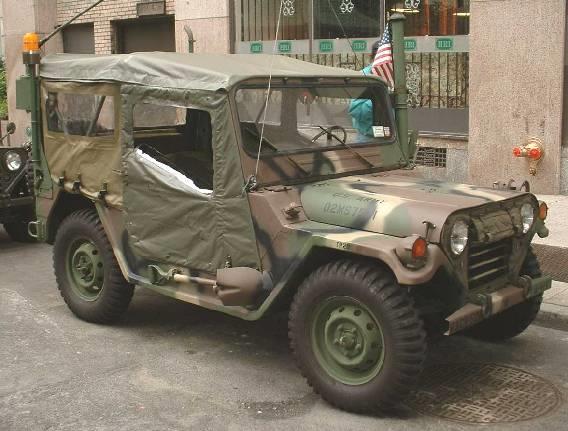
An M151 jeep with its canvas on
I was married by then, so I took
a quick trip to my quarters, told my wife we were going to Cal
for a couple weeks,
threw all my gear in a duffle bag and headed out for the
battalion area. Of course, the MPs were sitting outside my
quarters
waiting for me. Some stupid reg about use of a military vehicle.
I gave them a song and dance, skated out of a DR,
and made a quick stop at the commissary for smokes and munchies.
Of course, the MPs were waiting for me there too.
I gave them another story about moving down-range and this was
all for the 1SG’s welfare fund. In those days the 1SGs
& CSMs kept a slush fund for emergencies & welfare items
for the troops. The money was usually “donated” when an
NCO
made a minor mistake that didn’t warrant ruining his career.
I had made a few donations myself. When I got back
to the battalion area, Maj. Lumen (Incredible Hulk, our Bn XO)
gave me a piece of chalk and a 3x5 index card
with a long string of letters & numbers on it. He told me to
write the numbers on the hood, back, and both sides of HQ6.
I had never heard of a convoy ID before and asked him what it was
for. He told me anytime a convoy moved between states
it was given a control number. Security breach, we weren’t
supposed to know where we were going. He also told me
he was the convoy commander & would be riding with me. This
also spoke volumes. LtC Curcio would be moving
separately by air, it was considered a high-value target for a
Maj to be on it, and that Maj Lumen was spoiled. LtC Curcio
was a very short man, so I had put 6” foam rubber under his
seat cushion. It made a very comfortable ride.
At 1600 they had us move all
wheeled vehicles to a marshaling area near the division light
line next to I-25. We lined all vehicles
up in a set order with Maj. Lumen making sure we were in order.
He also had a shake-down of all vehicles to get rid of the dope
(it didn’t work out well for him). A squad of MPs showed up
to guard all vehicles at 1800 and Maj. Lumen told me to be at
Bn HQ at 0400 the next morning. He also let a few more details
slip, like there would be a ‘little bird’ (OH-58)
flying with us
and that the MPs were attached to us for the duration. I viewed
the MPs much the same as the KGB, so I had each company
assign 4 guards for their own vehicles. Never did trust MPs.
The next morning as the sun was
just coming up, two Colorado state patrol cars pulled off to the
side of I-25 with their lights on.
An MP went over, cut the barbed wire, and pulled it out of the
way. I had seen deployment like this in Germany,
but never state-side. Maj. Lumen climbed in, pointed to the
highway, and told me to head for Mexico. I dropped down
in the ditch and up onto I-25, hung a right for Mexico and 300
wheeled vehicles followed in three chocks of 100 each.
I had put an orange marker panel across the hood so Maj.
Lumen’s buddies could spot him easily. He was a loach pilot
himself.
We made it about 20 miles before Bulldog6’s (2nd Bde Cdr)
jeep lost the front right wheel. That kid never listened
when I told him not to reuse cotter pins. He was just lucky
Bulldog6 wasn’t with him, but he was great entertainment.
A high-gloss paint job on a tactical vehicle broke down on the
side of the Interstate. I had done a few modifications on HQ6,
so I could get 75mph out of her. We spent the first day laughing
our ass off at civilians who had never seen that many military
vehicles.
I ran the length of the convoy while the XO tried to get the
deuces to maintain their spacing. Obviously he had no idea about
deuces.
We hit Albuquerque about 2000
hrs the first night and had city motorcycle cops to lead us in to
the National Guard armory there.
It was tight getting all the wheels into the field there, but we
got it done. There was a Maint team from 704th set up already.
They had moved out a day ahead of us without anyone knowing about
it. Our budgets were extremely tight then and I saw
that we had an open wallet here. I had been trying to get a new
clutch for a few months and saw the opportunity here.
The maint team said they would just swap out the whole
power-train for me. My trannie had gearing from a CJ5 in it
and I didn’t want anyone putting a M151 trannie in it much
less messing with my engine. I talked them into just putting
a new clutch in for the nominal fee of a case of beer. By sunrise
the next morning they had everything running right
except for the 49C (aviation fuel tanker for the little bird)
that had thrown a torsion bar the previous day.
It made the trip on the back of an Oshkosh HET (M-911 as they are
called now).
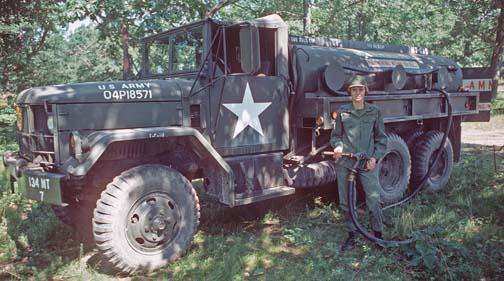
An M49A2C fuel tanker - 1976
Photo from Olive-Drab
Day 2 had us on 2-lane highways
because there were no Interstates westbound to Needles. We spent
most of it driving
on the shoulders so we didn’t screw up civilian traffic. The
MPs were in GSA vans and ran ahead for traffic control at each
town.
There were a bunch of pissed off cops that day. When we reached
the Interstate, Maj Lumen had me push it so he could get
to the Arizona line well in advance of the main body. We stopped
at the Port of Entry for Arizona and had one of their
state troopers tell us we had to have the entire convoy stop for
inspection. About that time the HET with the 49C on it
came blasting past laying down on the air horn. Maj. Lumen
cracked up. He told the trooper that unless he had about 300 cars
he would play hell stopping us. He also informed the trooper that
we were a federal convoy operating on federal highways
and that he could send his ticket to the CG at Ft. Carson. I got
a real clear picture of why Maj. Lumen was one of the oldest
Majors in the Army. He just wanted to fly. Day 2 went well
without the loss of a single vehicle. We rolled into
what we had been told was the Needles city park about 1600 that
day. The park turned out to be the closed landfill.
What an interesting stay we had. A couple methane explosions from
our smoking, the stench was so bad, a lot of us slept
with our mask on. We were glad to roll out on day 3.
Day 3 was a typical California
spring day. Off came the doors. It was great driving. Scared the
crap out of Maj. Lumen
when he saw what he thought was a Maint deuce heading in the
wrong direction. All of a sudden he yells “Stop that
deuce.”
Being the ever obedient soldier I was, I hit the brakes, did a
power-slide into the flood control ditch between lanes,
and caught air coming out on the other side of the Interstate.
Turned out the deuce belonged to the CA NG and thought I was
crazy.
Maj. Lumen had the OH-58 land and pick him up. Don’t know
why he didn’t want to ride with me anymore.
We got off the Interstate without ever seeing Barstow, drove for
two lifetimes until we got to “Ft. Irwin.” It looked
like
something out of a WWII army movie. The MPs had the main gate
manned and were laughing as we rolled in. There was a small PX,
one 3-story modern barracks, and the MPs guard shack. Everything
else was WWII wood buildings. There wasn’t a vehicle
in sight. Just us and dust. Maj. Lumen had flown ahead to scout
it out. He hopped on the hood and pointed the way.
I stopped at a single-story wood building about the size of a
small 2 bedroom house where he told me it would be my
Bn HQ for the next 6 weeks. The barracks were old single-story
shotgun buildings. Only one of them was in any shape to sleep in.
I wound up racking out with Joe Davis in a small room in the back
of Bn HQ. We spent the next 4 days cleaning out the building
and running out the animals/snakes. On the third day there we off
loaded the conex containers and tried to come up with
an arms room that would come close to regs. The evening of the
fourth day, Maj. Lumen told me to crank it up for a little drive.
We took off toward the middle of nowhere and wound up at an Air
Force base that I couldn’t even find on the map.
There were 4 C-141s on the
ground with a couple more in holding patterns. Finally, things
would get back to normal.
I think I was having separation anxiety from Reg6. The strip had
4 F4 Phantoms on the apron, nothing else in sight.
Not one single person, not even Air Force ground crews. Eight
buses from Ft. Ord showed up with a couple TMP trucks
for bags. The 22nd had arrived. LtC Curcio, CSM Pesta, & I
spent the next few days doing some great four-wheeling.
It was fantastic. Miles and miles without a single road, no
tracks across the desert, nothing except an occasional B-52 way
up.
The PX had been manned along with a non-appropriated and stocked
from Ft. Ord the day after we arrived.
There were 6 civilians at a facility maintenance shop, a civilian
care-taker that lived there, and a manned fire station.
One of the civilian maint guys told me the post was used a couple
times a year for California National Guard and not much else.
They were there to maintain the APCs. They were old M113s, the
originals with gas engines. We used M113A1s with
Cummins 350s in them. We had a few headaches trying to start them
without flooding the engines. They had nowhere near the power
we were use to, they couldn’t even climb most of the ridges.
They did however have heaters in them when we got there.
Most of the heaters disappeared before we left along with
anything else we thought we could use back at Carson.
A group from G-3 showed up the
third day and we started identifying what we wanted where. There
wasn’t even
a designated Impact Area, just a blank slate. We found a great
hill for a mad-minute range & I figured out why we had the
HETs with us.
They hauled in a bunch of Korea era self-propelled howitzers and
M-47 tanks to use for targets. On our first trials at our ranges
we had air support flying for us. This was the first time any of
us had seen an A-10. We knew we had air coming in on us
and expected A-6s or F4s that you could hear well in advance.
Scared the crap out of us when all of a sudden we hear
a brrrrrr sound and the tank we are attacking disappeared in a
cloud of dust. THEN we hear the A-10s about the same time
we saw their shadows. It may be kind of hard for later troops to
understand, but we were used to fast-movers being slowed down
as much as they could for close air support. They were noisy and
couldn’t linger on target. Only the A1 Sandy’s could
linger.
We loved this bird, a bird built for grunts. It was also the
first time many had seen a B-52 strike. I had seen a few strikes
and I was impressed. The first bomb run after 9/11 when Bush had
them blow up a ridgeline for the cameras looked just like
the first run we had at Irwin. Very impressive watching a
ridgeline disappear from 3 aircraft. We had an ALO team with us
that were trying out a laser target designator. It was mounted on
a wooden rifle stock and had about a 5 minute battery life.
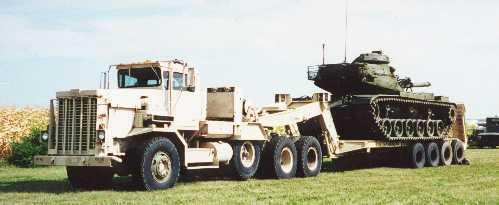
An M911 tractor and M747
trailer carrying an M60 tank.
Built by the Oshkosh Corporation, they were also called HET
(Heavy Equipment Transporter)
Photo from PD-USGOV-MILITARY-ARMY
We almost lost a scout track
that broke down in the target area for an airstrike when we found
out we couldn’t talk directly to the birds.
We had the MILES test equipment with us but they hadn’t
gotten far enough into it for the aircraft to be outfitted.
We were told that would come later if it worked. At that time a
.50 cal could kill a tank according to MILES. We had no
Range Safety the first few days. Everything operated off red
smoke or star-clusters. CSC’s 4.2 crews fired a short-round
that took out the battalion’s ammo dump. A soldier from the
tank company we had attached from 1/77 Armor was run over
by his Plt Ldr’s tank while he was sleeping. I was told they
just buried the sleeping bag. We found out those pretty dried
lake beds
won’t support a PLL tanker. It took an M-88 to get it out.
We found out HQ6 was the only vehicle in the task force that had
enough power/weight ratio to make it to the top of the taller
ridges. We learned a LOT about desert commo.
Radios do strange things in the desert. A few city boys learned
the hard way about flash floods. Being from Ft. Hood,
I was already well acquainted with them. We learned LSA and dust
do nasty things to an M16. Don’t cover up with a poncho,
something about a solar still means you will wake up wet.
Of course, the biggest thing we
learned was how to maneuver as a team with main battle tanks and
APCs. It was all new to us then.
We always operated as pure INF and pure Arm. An M-113 will never
keep up with an M-60. I imagine the same is true with
Abrams and todays Strykers/Bradleys. It was kind of strange using
our APCs as bait to set up targets for the 60s.
Even stranger using both to set up targets for air. We had an
aggressor force we only saw in the field. I have no idea
who supplied them or where they stayed. We never saw any
strangers in garrison. One afternoon about 4 weeks into it,
I commented to CSM Pesta & LtC Curcio that it would be great
to be assigned as a permanent Aggressor at Irwin.
Things got real quiet in the jeep for a few moments before LtC
Curcio told me that Irwin was going to be the NTC
and what that meant. He also told me that there was going to be a
permanent Aggressor Force assigned to Irwin.
He never mentioned it again, nor was any mention of how I could
get assigned as Aggressor there. I think it might have
something to do with my collection of ART15s in my record jacket.
The only major flaw in the whole plan was that
we didn’t take any Arty with us. Just wheels & bodies.
All tracks were old models that were stored at Irwin.
There were no tubes or small
arms stored at Irwin. We learned things went much smoother when
you didn’t have Bulldog6
or anyone from division looking over your shoulder. We made a
couple trips into Barstow on the week-ends. HQ6 turned a few
heads.
It was a serious four-wheeler for its time. Of course having two
Italians with me, we found all the great places to eat.
Never had to pay for a meal or a drink while I was there. An E-4s
pay wasn’t great then and the first time I pulled out my
wallet,
CSM Pesta just shook his head at me. Never a word spoken about
it. The people of Barstow loved it when we came into town.
It wasn’t because of the extra revenue or anything. They
just liked seeing us. A lot of them knew nothing about the
military
except what CBS told them. They liked looking over our wheels and
talking to us about what we were doing. It didn’t hurt
that the first time we went to town there was a bad storm. We
used our deuces and 5-tons to ferry everyone across the washes
until the water went down. I think a lot of them just wanted a
ride in a military truck for a change.
Our time with the Air Force was
well spent too. They learned their jeep mounted radio pad
couldn’t keep up with tracks.
We learned that Army and Air Force spoke two different languages.
On one occasion this was literal. An in-bound F-4
had a Scottish pilot. We couldn’t understand a word he said.
Lucky for us we had a British Major attached to us.
Later he would become our XO when we swapped C-Co to the
Australian Army for 8 weeks. The terminology used to talk
to strike aircraft was very precise then. You had to know what to
ask for or the birds could wind up on us.
They were all fast-movers that seldom saw the actual targets.
They just went to a grid reference and blew the crap out of it.
All commo was through 3 or 4 links until we had an ALO jeep
attached. The ALO was an airman that the beefed-up M-151A2
belonged to with a pilot from a fighter squadron attached.
Usually the pilot was from the squadron that was supporting us,
so they personally knew the jet-jockeys above. They knew their
style and abilities first hand. More than once at Irwin,
they showed up for a few beers with us after flying above us all
day.
We didn’t do a lot of night
ops when we were there. All we had for night vision back then
were Starlight scopes
that never worked if you could get batteries for them and PVS-4s
with zero depth-perception. We didn’t do any serious NBC
ops,
just CS. At that time all it consisted of was putting on your
poncho and M-19??? Gas mask. Aberdeen was testing out
a new full suit I hear later troops learned to hate. Everything
was live fire while we were there with no shake-downs for ammo
until the day before we moved back to Carson. Use of CS was daily
to get us use to wearing mask all the time.
I didn’t even have inserts for my mask and I’m blind as
a bat without my glasses. Lucky for us I don’t rely on sight
to drive.
Keep in mind that all of this was happening while we were used to
having fuel rationed out to us, parts were non-existent,
and a pay raise was a dream.
Our last eight days at Irwin
were spent full tactical, no admin breaks. Unheard of in
TRADOC’s planning scheme.
We never saw a building, always unassed an AO when we had fired,
no sleep, no hot chow, mail never did catch up to us,
all commo was as if the Russians had direction finders on us, and
we never once drove on a road. We had live-fire
against Air Force drones (they were pretty safe). We got to fire
live Redeye AA missiles, something the gunners
had never done because we couldn’t get them. Turns out a few
years later, we learned that we couldn’t get them
because the entire production was being sent to Afghanistan. We
had a Hawk missile battery from Ft. Ord sent out.
They were a joke and never hit a drone. One blew up about a klic
off the rails. Believe it or not, the grunts got more hits
on a drone with the ‘wall of fire’ approach than anyone
else. We even had the TOC run through the air defense segment.
Not much fire power in 3 M-577s, just a lot of M-16s. When we
moved back into garrison at Irwin, we had one day
to pack up before we convoyed back to Carson. There was a VERY
serious shake-down once we moved everything
to the marshaling area. Even had a couple from battalion maint
arrested by the MPs for ammo & grass hidden in the wrecker.
SSG Warren, Bn Maint NCO, wound up having to drive back to Carson
with the wrecker.
All told, I would have to say
that sending the 22nd to Irwin was one of the few intelligent
things done during my tenure
with the Regulars. It was well spent money. We lived in the
desert, turned out we didn’t need the old barracks after
all.
We went back to Carson a much tighter team than when we left.
There was no more stealing parts from 1/77 Arm,
they belonged to us and we to them. We stole from 1/10 Cav and
1st Bde instead, 704th knew how to lock stuff up tight.
We didn’t look down on the “tread-heads” anymore.
We still called them that, but that was like us calling ourselves
grunts.
The lines quickly blurred between 1/77 Arm and 1/22 INF after
Irwin and I think it was a good thing. This took place
at a time when Congress despised the military and funding was
non-existent. Throw in OPECs oil embargos, high desertion rates,
and extremely low morale and you get an idea how unusual an
opportunity this was for us. Unheard of except for Ft. Hood.
Plus it was great operating somewhere you didn’t know every
gully of and no tank trails either..
By Don Krewson © 2011
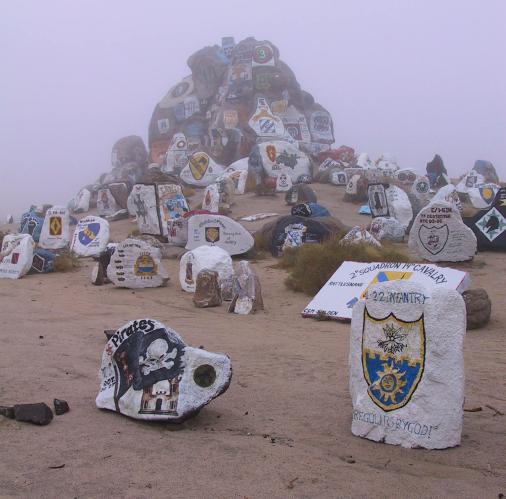
The unit rocks just
outside the gate at Ft. Irwin.
1-22 Infantry rock at right foreground.
1/22 Infantry was the
first unit to paint its insignia on the large boulder in the
background, in 1978.
Since then the boulder has been overpainted numerous times.
Photo by Andrei Pashkin
Home | Photos | Battles & History | Current |
Rosters & Reports | Medal of Honor | Killed
in Action |
Personnel Locator | Commanders | Station
List | Campaigns |
Honors | Insignia & Memorabilia | 4-42
Artillery | Taps |
What's New | Editorial | Links |